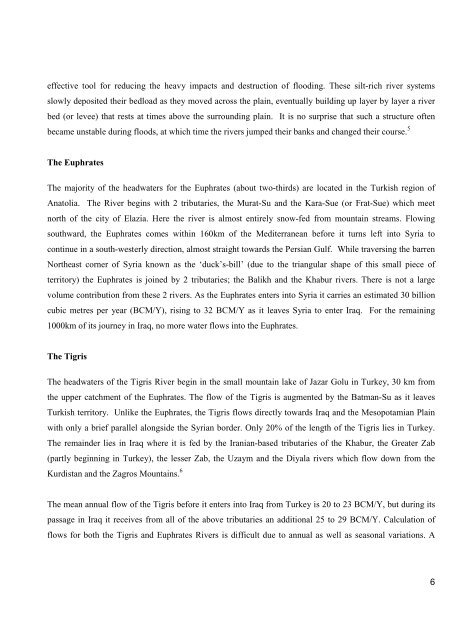hydropolitics of the tigris - euphrates river basin with - ceris.be
hydropolitics of the tigris - euphrates river basin with - ceris.be
hydropolitics of the tigris - euphrates river basin with - ceris.be
Create successful ePaper yourself
Turn your PDF publications into a flip-book with our unique Google optimized e-Paper software.
effective tool for reducing <strong>the</strong> heavy impacts and destruction <strong>of</strong> flooding. These silt-rich <strong>river</strong> systems<br />
slowly deposited <strong>the</strong>ir <strong>be</strong>dload as <strong>the</strong>y moved across <strong>the</strong> plain, eventually building up layer by layer a <strong>river</strong><br />
<strong>be</strong>d (or levee) that rests at times above <strong>the</strong> surrounding plain. It is no surprise that such a structure <strong>of</strong>ten<br />
<strong>be</strong>came unstable during floods, at which time <strong>the</strong> <strong>river</strong>s jumped <strong>the</strong>ir banks and changed <strong>the</strong>ir course. 5<br />
The Euphrates<br />
The majority <strong>of</strong> <strong>the</strong> headwaters for <strong>the</strong> Euphrates (about two-thirds) are located in <strong>the</strong> Turkish region <strong>of</strong><br />
Anatolia. The River <strong>be</strong>gins <strong>with</strong> 2 tributaries, <strong>the</strong> Murat-Su and <strong>the</strong> Kara-Sue (or Frat-Sue) which meet<br />
north <strong>of</strong> <strong>the</strong> city <strong>of</strong> Elazia. Here <strong>the</strong> <strong>river</strong> is almost entirely snow-fed from mountain streams. Flowing<br />
southward, <strong>the</strong> Euphrates comes <strong>with</strong>in 160km <strong>of</strong> <strong>the</strong> Mediterranean <strong>be</strong>fore it turns left into Syria to<br />
continue in a south-westerly direction, almost straight towards <strong>the</strong> Persian Gulf. While traversing <strong>the</strong> barren<br />
Nor<strong>the</strong>ast corner <strong>of</strong> Syria known as <strong>the</strong> ‘duck’s-bill’ (due to <strong>the</strong> triangular shape <strong>of</strong> this small piece <strong>of</strong><br />
territory) <strong>the</strong> Euphrates is joined by 2 tributaries; <strong>the</strong> Balikh and <strong>the</strong> Khabur <strong>river</strong>s. There is not a large<br />
volume contribution from <strong>the</strong>se 2 <strong>river</strong>s. As <strong>the</strong> Euphrates enters into Syria it carries an estimated 30 billion<br />
cubic metres per year (BCM/Y), rising to 32 BCM/Y as it leaves Syria to enter Iraq. For <strong>the</strong> remaining<br />
1000km <strong>of</strong> its journey in Iraq, no more water flows into <strong>the</strong> Euphrates.<br />
The Tigris<br />
The headwaters <strong>of</strong> <strong>the</strong> Tigris River <strong>be</strong>gin in <strong>the</strong> small mountain lake <strong>of</strong> Jazar Golu in Turkey, 30 km from<br />
<strong>the</strong> upper catchment <strong>of</strong> <strong>the</strong> Euphrates. The flow <strong>of</strong> <strong>the</strong> Tigris is augmented by <strong>the</strong> Batman-Su as it leaves<br />
Turkish territory. Unlike <strong>the</strong> Euphrates, <strong>the</strong> Tigris flows directly towards Iraq and <strong>the</strong> Mesopotamian Plain<br />
<strong>with</strong> only a brief parallel alongside <strong>the</strong> Syrian border. Only 20% <strong>of</strong> <strong>the</strong> length <strong>of</strong> <strong>the</strong> Tigris lies in Turkey.<br />
The remainder lies in Iraq where it is fed by <strong>the</strong> Iranian-based tributaries <strong>of</strong> <strong>the</strong> Khabur, <strong>the</strong> Greater Zab<br />
(partly <strong>be</strong>ginning in Turkey), <strong>the</strong> lesser Zab, <strong>the</strong> Uzaym and <strong>the</strong> Diyala <strong>river</strong>s which flow down from <strong>the</strong><br />
Kurdistan and <strong>the</strong> Zagros Mountains. 6<br />
The mean annual flow <strong>of</strong> <strong>the</strong> Tigris <strong>be</strong>fore it enters into Iraq from Turkey is 20 to 23 BCM/Y, but during its<br />
passage in Iraq it receives from all <strong>of</strong> <strong>the</strong> above tributaries an additional 25 to 29 BCM/Y. Calculation <strong>of</strong><br />
flows for both <strong>the</strong> Tigris and Euphrates Rivers is difficult due to annual as well as seasonal variations. A<br />
6





